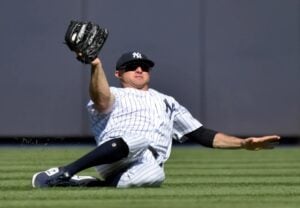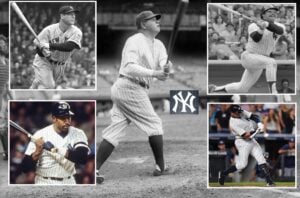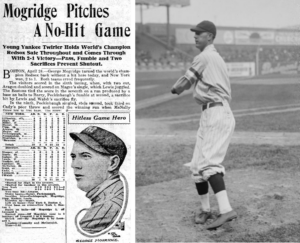Phil Rizzuto: The Yankees Scooter
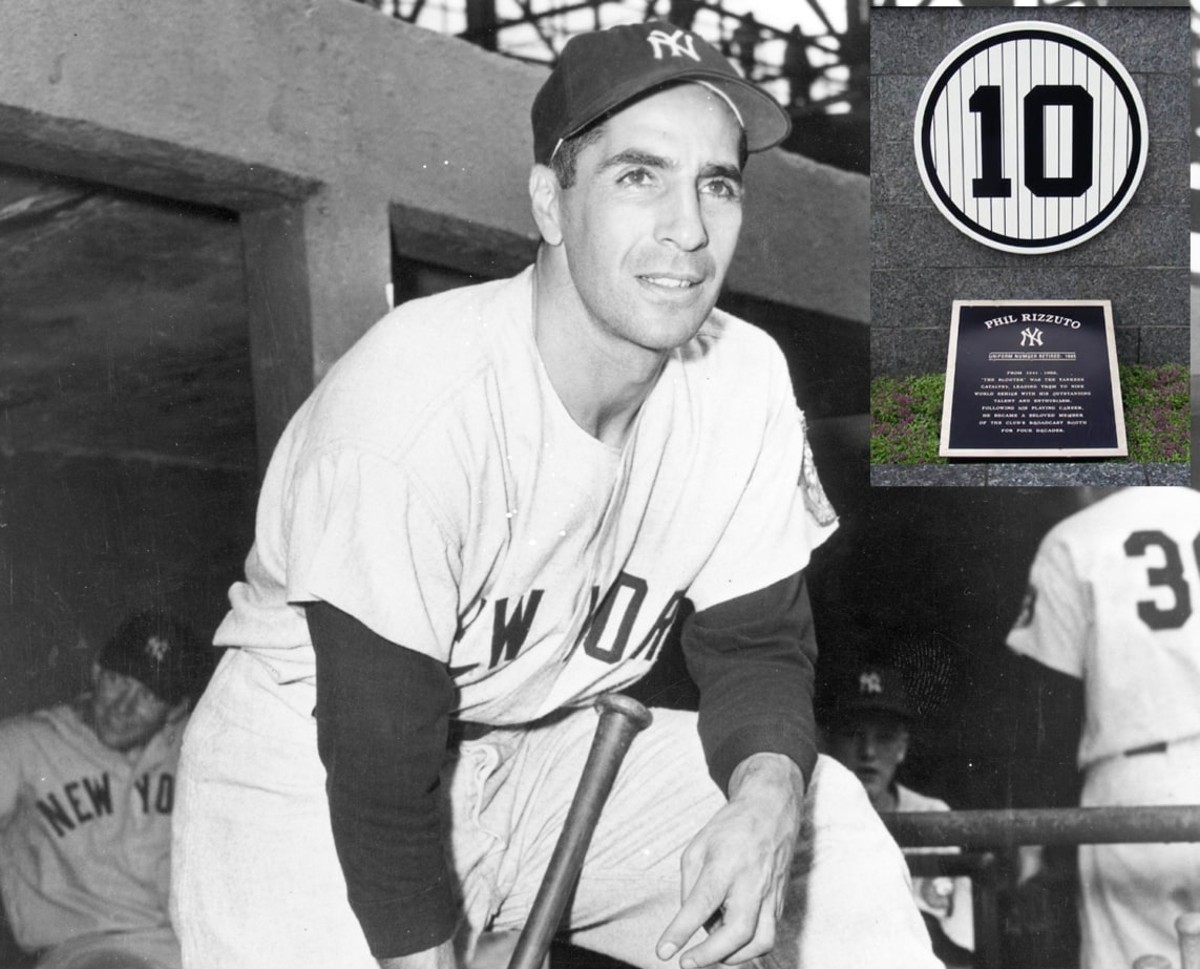
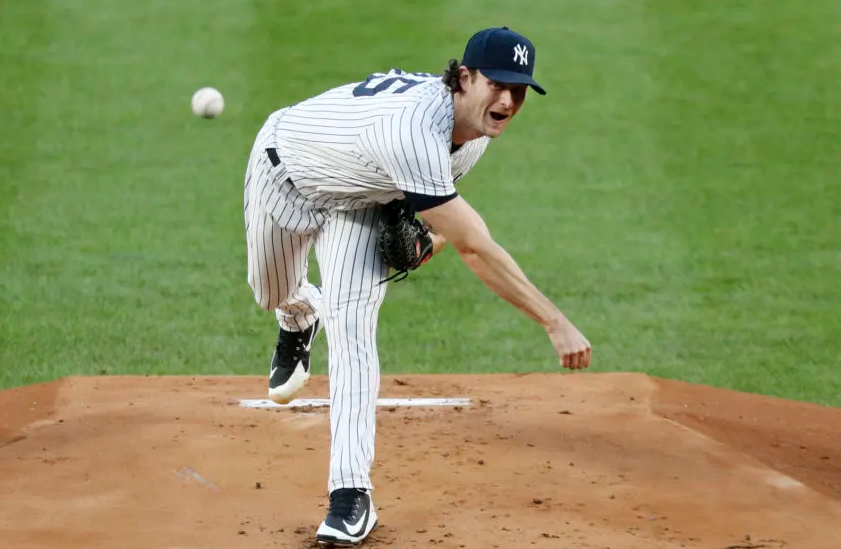
Michael Bennington
More Stories By Michael Bennington
- Mother’s Day: How Anthony Volpe’s mom molded him into a Yankee phenom
- Yankees’ Gleyber Torres projected to sign with NL West contender
- Yankees keeping tabs on Santander while Soto decision looms, says insider
- Hal Steinbrenner calls Juan Soto talks ‘good’ as Yankees weigh free agency moves
- Dave Sims excited to fill big shoes in Yankees booth, Sterling mulls weekly show
Table of Contents
| Position | Shortstop |
| Active years | 1941-1956 |
| Teams (years) | New York Yankees (1941–1942, 1946–1956) |
| Draft | 1937 |
| Debut | April 14, 1941 (New York Yankees vs. Washington Nationals) |
| Last game | August 16, 1956 (New York Yankees vs. Boston Celtics) |
| Date of Birth | September 25, 1917 |
| Native place | Brooklyn, New York, U.S. |
| Batted | Right |
| Threw | Right |
| All-Star | 5× All-Star (1942, 1950–1953) |
| World Champions | 7× World Series champion (1941, 1947, 1949–1953) |
| AL MVP | AL MVP (1950) |
| Shirt retired | New York Yankees No. 10 retired |
| Hall of Fame year | 1994 (Voted by Veteran’s Committee) |
| MLB Awards | 1950 Major League Player of the Year 1950 AL MVP 1951 AL Babe Ruth Award |
| Legacy | New York Yankees No. 10 retired Monument Park honoree |
| Nickname | Scooter |
Phil Rizzuto, affectionately known as “The Scooter,” had a remarkable career exclusively with the New York Yankees, spanning from 1941 to 1956. Following his retirement as a player, this talented shortstop transitioned into a beloved broadcaster, known for his unwavering support of the Yankees. He brought a touch of levity to his commentary, such as extending birthday wishes to fans and exclaiming “Holy cow!” in moments of excitement during games. Standing at just five feet and six inches and weighing 150 pounds, Phil Rizzuto made history by securing a Most Valuable Player award, earning a spot in the prestigious Hall of Fame, and dedicating four decades to serving as the Yankees’ radio and television voice.
A prominent figure in the Yankees’ dynasty that clinched an astounding 10 AL titles and seven World Championships during his 13-season tenure, Phil Rizzuto boasts an array of World Series records for shortstops. His standout statistical performance transpired in 1950, a year that saw him crowned as the American League’s Most Valuable Player. Phil Rizzuto was recognized as a “small ball” player, celebrated for his exceptional defensive skills in the infield and his adept bunting abilities. When he called it a career, his tally of 1,217 career double-plays ranked second in major league history, trailing only Luke Appling’s total of 1,424, while his .968 career fielding average was surpassed by only Lou Boudreau’s .973 mark among AL shortstops.
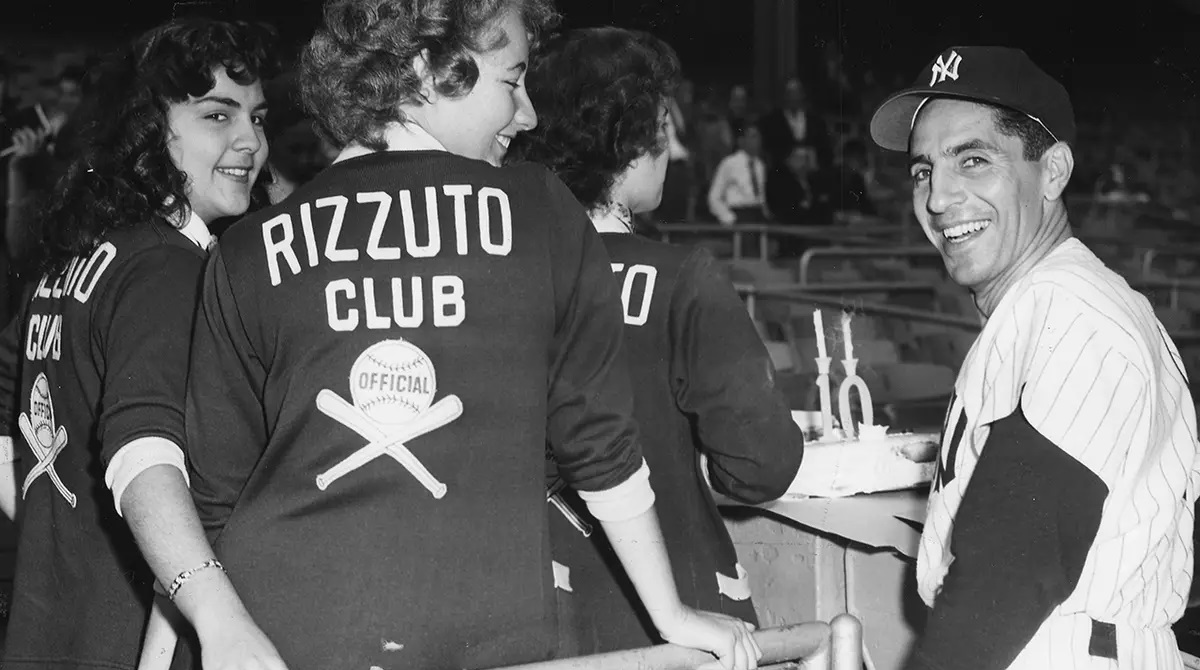
Over his illustrious 13-season career, Phil Rizzuto indelibly etched his name in World Series history, setting multiple records for shortstops. The pinnacle of his accomplishments arrived in the 1950 season when he was honored as the American League’s Most Valuable Player. Revered for his extraordinary bunting prowess and defensive acumen, Phil Rizzuto played an instrumental role in guiding his teams to an astonishing 10 American League pennants and seven World Series championships. He was a vital part of the Yankees’ consecutive World Series victories from 1949 to 1953, a total of five titles in a row. Phil Rizzuto’s well-deserved induction into the National Baseball Hall of Fame came in 1994. His contributions were instrumental in securing the Yankees’ five consecutive World Series titles from 1949 to 1953, and an additional championship in 1955.
Early life and career
Philip Francis Rizzuto, born on September 25, 1917, in Brooklyn to Fiore and Rose (Angotti) Rizzuto, hailed from a family with a strong work ethic. His mother originated from Italy, while his father was a native of the United States. In a candid 1993 interview, Phil Rizzuto enthusiastically recounted his family and childhood in Brooklyn. He remarked, “They were laborers, building homes, sidewalks, and garages in New York City and Long Island.” Eventually, his father found employment as a trolley car motorman and later as a dock watchman.
Initially baptized as Fiero, Phil Rizzuto opted to go by the name Phil, following in his father’s footsteps. Even in his youth, Phil Rizzuto faced the challenge of disproving the belief that he was too small to become a baseball player. He began to establish himself as a talent while playing for Richmond Hill High School in Queens. By the summer before his senior year, he had already demonstrated his skills enough to play for a semipro team under an assumed name.
Like many Italian fathers of his time, Fiore Rizzuto initially regarded baseball as a frivolous pursuit and discouraged his son from pursuing it. It was Mrs. Rizzuto’s support for her son’s passion for the game that eventually persuaded his father to relent. Phil Rizzuto attended Richmond Hill High School and even attempted to try out for the Brooklyn Dodgers. However, their manager, Casey Stengel, informed him that he was too small for baseball. Phil Rizzuto encountered a similar rejection from the New York Giants. However, Stengel’s words left a lasting impression as he famously suggested that Phil Rizzuto should “go get a shoeshine box.”
Phil Rizzuto later recalled that when Casey Stengel assumed the role of Yankee manager in 1949, he brought up this incident, but Stengel pretended not to recall it. Phil Rizzuto humorously added that by 1949, he no longer needed a shoeshine box, and the clubhouse attendant at Yankee Stadium took care of polishing his Yankee spikes daily.
In 1937, Phil Rizzuto was signed by the New York Yankees and began his professional career with the Bassett Furnituremakers in the Class D Bi-State League in Bassett, Virginia. He quickly ascended through the Yankees’ farm system. After an impressive season with a .336 batting average at Norfolk in the Piedmont League in 1938, he was transferred to Kansas City in the American Association. During his two years at Kansas City, Phil Rizzuto continued to excel, and in 1940, with 201 hits and a .347 batting average, he was honored as the MVP of the American Association and received the title of Minor League Player of the Year by The Sporting News, earning him the iconic nickname “Scooter” from his teammate Billy Hitchcock.
The MLB debut
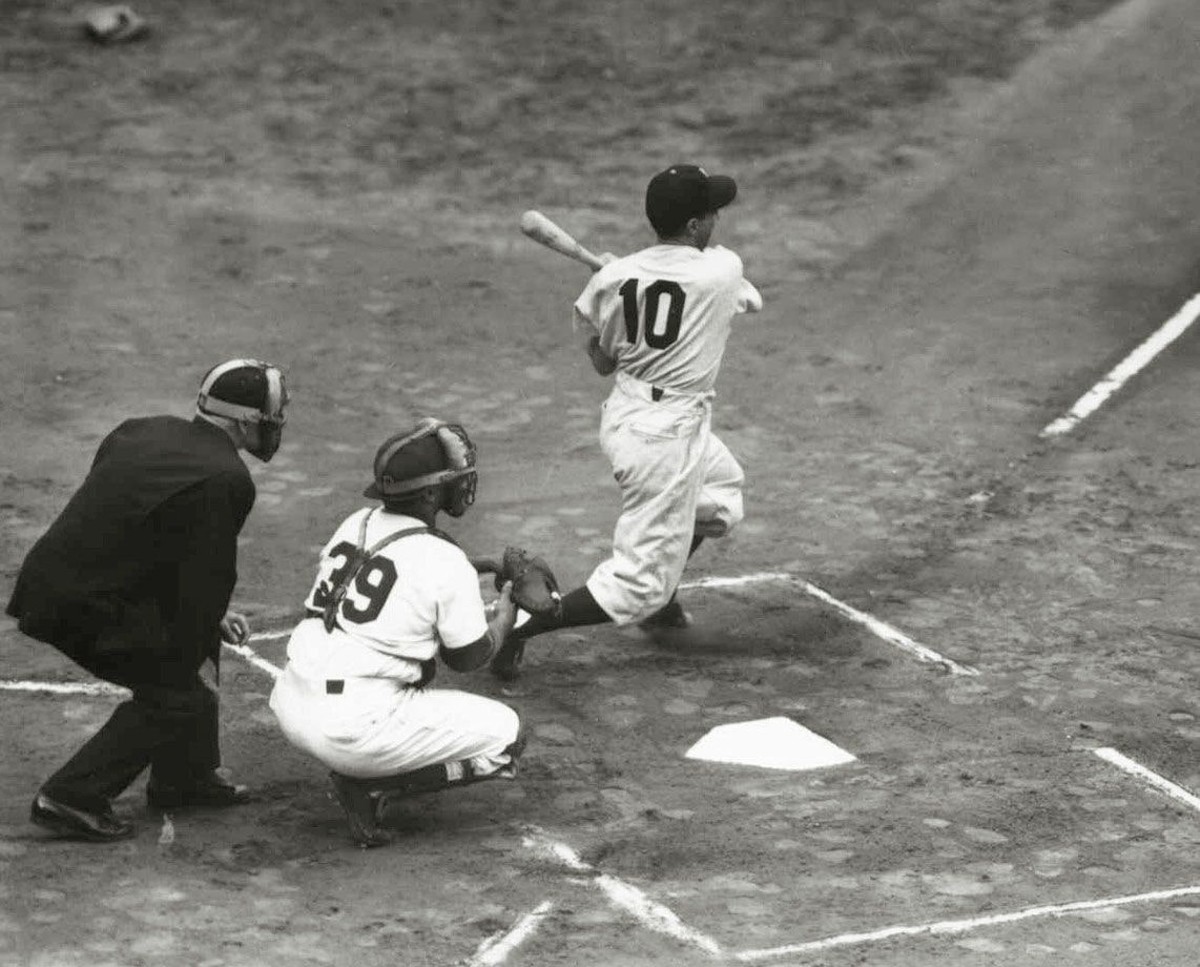
In 1941, when Phil Rizzuto arrived at the Yankees‘ spring training camp, his diminutive stature prompted Lefty Gomez, a pitcher, to question why the team had called in a “Lilliputian.” Nevertheless, Phil Rizzuto swiftly dispelled any doubts, taking the place of the veteran Frank Crosetti and achieving an impressive .307 batting average in his rookie season.
However, assuming the role of a Yankee was no walk in the park for Phil Rizzuto, even after replacing the beloved Frank Crosetti. Some players initially tried to prevent him from using the batting cage, but Joe DiMaggio stepped in and insisted that Phil Rizzuto be allowed to take his turn at hitting.
Phil Rizzuto emerged as a cornerstone of the Yankees’ infield, forming formidable double-play partnerships with second basemen such as Gerry Priddy, Joe Gordon, and Jerry Coleman (who would later join Rizzuto in the broadcast booth during the 1960s). Phil Rizzuto also embraced his unique quirks, displaying a sense of humor, superstitions, a fear of thunder, and often being the target of playful pranks. In the past, players used to leave their gloves on the field when going up to bat, and sometimes, Phil Rizzuto would find surprises like mice, snakes, or even rats stuffed inside the glove fingers upon his return to the field.
Phil Rizzuto was slated to be the Yankees’ starting shortstop in 1941 after Frank Crosetti, who had held the position since 1932, posted a meager .194 batting average in 1940. Yet, despite Phil Rizzuto’s undeniable talent, the veteran Yankees initially resented the rookie who threatened to replace the popular Crosetti. Players made attempts to keep him away from the batting cage until Joe DiMaggio intervened, instructing them to let the young talent have his turn. Phil Rizzuto recollected, “I had a rough time. Crosetti was one of their big favorites and a great guy, and here I was, a fresh rookie trying to take his job.”
The twenty-three-year-old rookie eventually took over Crosetti’s role in the starting lineup when the 1941 season began. Crosetti himself was more supportive of his successor than some of his teammates had been initially. Phil Rizzuto recalled how the veteran assisted him during his first game against the Washington Senators, saying, “If it hadn’t been for Crosetti, I’d have looked like a bum. He made me look great.” Given the opportunity, Phil Rizzuto demonstrated his worth, finishing with a .307 batting average, second only to DiMaggio’s .357 among Yankees players. In 1942, he continued to impress, hitting .284, earning an All-Star team selection, and leading American League shortstops in double plays and putouts. In the Yankees’ five-game World Series loss to the St. Louis Cardinals, he batted an impressive .381.
Like many other major leaguers, Phil Rizzuto dedicated the following three years to military service, initially playing baseball at the Naval Training Station in Norfolk, Virginia. It was during this time, in June 1943, that he married Cora Esselborn.
Upon his return from the war, Phil Rizzuto received an enticing offer from the Mexican League, which sought to lure players away from the Major Leagues. In early May 1946, Jorge Pasquel, a wealthy industrialist and league president, offered Phil Rizzuto a five-year contract worth $12,000 per year and a $15,000 signing bonus.
After a lackluster 1946 season, both for the Yankees (who finished third) and Phil Rizzuto (whose average dropped to .257), the “Scooter” made a strong comeback in 1947, hitting .273 and driving in sixty runs. He led the Yankees in games played, stolen bases, and the league in being hit by pitches.
In the memorable World Series against the Dodgers, which marked the first of six “Subway Series” contests between the interborough rivals from 1947 to 1956, Phil Rizzuto played a pivotal role. In the deciding seventh game, he helped the Yankees secure a 5-2 victory. Phil Rizzuto had a .308 batting average in the series, with only Johnny Lindell (.500) and Henrich (.323) outperforming him among Yankee starters.

Following a solid but unspectacular 1948 season, Phil Rizzuto enjoyed the best two years of his career. In 1949, he hit .275, scored 110 runs, and finished second in the MVP vote, trailing only Ted Williams. He followed that exceptional performance with a season in which he achieved career highs in hits, average, slugging percentage, runs, doubles, and walks. He even set a Major League record by handling 238 consecutive chances at shortstop without an error.
In 1950, Phil Rizzuto was honored as the American League’s MVP, securing sixteen of twenty-three first-place votes and comfortably outpacing Billy Goodman of the Boston Red Sox, with a total of 284 points compared to 180. In December, Phil Rizzuto signed a one-year contract for $50,000, making him the third-highest-paid player in Yankees history, following Ruth and DiMaggio.
The retirement
Starting in 1950, Phil Rizzuto’s career took a notable turn as he earned a spot on four consecutive All-Star teams, beginning with his selection as the starting shortstop in 1950 and 1952. In terms of MVP voting, he placed eleventh in 1951, fourteenth in 1952, and sixth in 1953. However, his performance dipped significantly in 1954, with a batting average of just .195. The following year, at the age of thirty-seven, he participated in only seventy-nine games at shortstop. On August 25, 1956, Phil Rizzuto received the surprising news from the general manager, George Weiss, that he was being released to make room on the roster for Enos “Country” Slaughter, one of the many experienced players the Yankees had acquired during that period to address lineup weaknesses. This abrupt and unceremonious exit marked the end of his illustrious thirteen-year career, during which he had become synonymous with the Yankees.
The man who had once been doubted due to his size had risen to become one of the finest shortstops of his era, earning five All-Star game appearances and participating in nine World Series with one of the greatest teams in baseball history. Yet, as his playing days abruptly concluded at the age of thirty-nine, the beloved “Scooter” embarked on a new career as a Yankees broadcaster. He initially teamed up with two other legendary broadcasters, Mel Allen and Red Barber. With his distinctive, stream-of-consciousness style, characterized by his signature exclamation of “Holy Cow,” Phil Rizzuto captivated Yankees fans for four decades and endeared himself to a new generation of followers.
When he retired from broadcasting in 1996 at the age of seventy-nine, Phil Rizzuto had devoted an astonishing fifty-three years to the Yankees, a record unmatched in the franchise’s history. In 1985, the Yankees honored his legacy by retiring his jersey number 10 and adding his plaque to the prestigious Monument Park at Yankee Stadium. During his typically meandering yet entertaining Hall of Fame acceptance speech in 1994, Phil Rizzuto humorously stated, “I’ve had the most wonderful lifetime that one man could possibly have.” His remarkable journey came to an end on August 13, 2007, leaving behind his wife Cora, and their four children.
The legacy
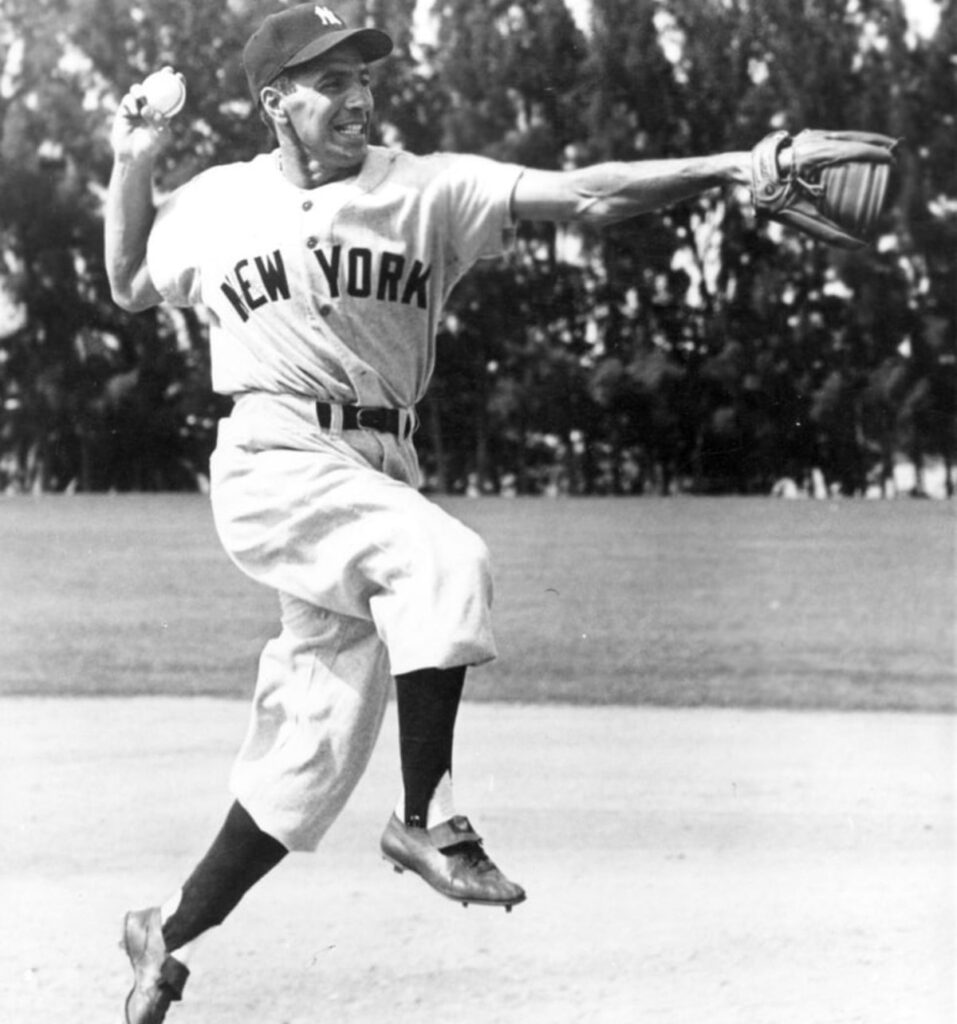
The 1984 induction of Pee Wee Reese into the Hall of Fame by the Veterans Committee sparked debates over Phil Rizzuto’s worthiness compared to his Dodger counterpart. Finally, on February 25, 1994, Phil Rizzuto received the long-awaited call from Yogi Berra, a member of the Veterans Committee, delivering the news that he had been inducted into the Hall of Fame. Phil Rizzuto’s immediate response? “Holy Cow!”
Phil Rizzuto, one of the most beloved players of his generation, enjoyed immense popularity with both fans and teammates. Although initially overlooked during his rookie season, Phil Rizzuto swiftly endeared himself to his fellow players through his youthful enthusiasm and his willingness to be the target of their lighthearted pranks. While he displayed scrappiness on the field, Phil Rizzuto paradoxically had a comical fear of insects and other small creatures, making him an even more inviting subject for jests.
Phil Rizzuto’s contributions to the New York Yankees’ remarkable success in the 1940s and 1950s, during which the team clinched 10 American League pennants and eight World Series titles over his 13 seasons with the club, were so significant that fellow Hall of Famer Ted Williams once remarked, “If the Red Sox had Phil, we would have won all those pennants.”
“I hustled and got on base and made the double play,” Phil Rizzuto said. “That’s all the Yankees needed in those days, somebody who could get on base, make the double play and not make too many errors. The other guys did all the work, all the RBIs and home runs.”
Standing at a mere 5-foot-6 and weighing 150 pounds, the man known as “Scooter,” Phil Rizzuto, made his debut in the Yankees’ lineup in 1941 and swiftly became an All-Star the following season. His baseball career took a brief hiatus from 1943 to 1945 when Phil Rizzuto served in the U.S. Navy. He returned to the diamond in 1946 and, by 1949, had evolved into both an offensive powerhouse and an exceptional defensive player. In that year, he secured the second spot in the American League Most Valuable Player Award voting, hitting .275 with 110 runs scored. The subsequent season marked his peak as he achieved career-highs in various categories, including hits (200), batting average (.324), on-base percentage (.418), runs (125), home runs (7), walks (92), doubles (36), and slugging percentage (.439). He not only achieved personal milestones but also clinched the AL MVP Award.
During Phil Rizzuto’s tenure as the starting shortstop, the Yankees claimed the World Series championship every year from 1949 to 1953. His illustrious career concluded following the 1956 season, leaving behind an impressive batting average of .273, 1,588 hits, 149 stolen bases, 38 home runs, 563 RBI, and five All-Star Game selections. Phil Rizzuto displayed his defensive prowess by leading all AL shortstops in double plays three times, putouts twice, and assists once.
Upon retiring, he ranked second in major league history for career double plays turned, boasting an impressive total of 1,217, second only to Luke Appling’s record of 1,424. Additionally, his remarkable career fielding average of .968 positioned him as the second-best among AL shortstops, trailing only Lou Boudreau’s remarkable mark of .973. Phil Rizzuto’s legacy as a skilled defensive specialist and a pivotal contributor to the Yankees’ unprecedented success endures as a celebrated chapter in baseball history.
The Yankees paid homage to Phil Rizzuto’s remarkable career by retiring his number 10 in a special ceremony at Yankee Stadium on August 4, 1985. During this memorable event, he was also honored with a plaque placed in the stadium’s Monument Park, a testament to his enduring impact on the sport.
Phil Rizzuto’s two most memorable games
Two pivotal plays from 1951 serve as enduring symbols of Phil Rizzuto’s remarkable career. In one memorable instance that unfolded during that season, the shortstop found himself in a high-stakes situation. He was at the plate, facing Bob Lemon of the Cleveland Indians, even though he was a right-handed batter. The scenario occurred in the bottom of the ninth inning, a critical moment in the pennant race. The game stood deadlocked at 1 run apiece, with Joe DiMaggio perched on third base. Phil Rizzuto made the decision to let Lemon’s initial pitch pass, even though the umpire deemed it a strike.

This choice led to a brief dispute with the umpire, providing Phil Rizzuto with the opportunity to adjust his grip on the bat. This adjustment signaled to DiMaggio their intent to execute a squeeze play on the next pitch. Unexpectedly, DiMaggio initiated his dash towards home base prematurely, catching Phil Rizzuto off guard. Realizing the situation, Lemon altered his pitch to aim high and away from Phil Rizzuto, attempting to thwart a successful bunt. However, in the face of these challenging circumstances and with DiMaggio swiftly closing in the Yankees’ “Scooter” managed to raise his bat and execute a successful bunt.
Phil Rizzuto later explained that if he hadn’t attempted the bunt, the pitch might have struck him in the head. With both feet off the ground, he expertly directed the bunt toward first base. This remarkable play allowed DiMaggio to score the winning run, an act of quick thinking and skill that manager Casey Stengel described as the most exceptional play he had ever witnessed.
In that same eventful year, during Game 3 of the World Series against the New York Giants, Phil Rizzuto encountered an opponent who would be a source of frustration for him throughout his life. In the fifth inning with one out, Eddie Stanky of the Giants drew a walk against the Yankees’ pitcher Vic Raschi. The next batter was Alvin Dark, and the Yankees deduced that a hit-and-run play was in the works. Yogi Berra, the catcher, signaled for a pitchout, and his throw to Phil Rizzuto at second base easily arrived ahead of Stanky, securing a substantial lead.
Greatest moments
- 1940 Minor League Player of the Year, Kansas City Blues, American Association
- 5-time AL All-Star (1942 & 1950-1953)
- AL MVP (1950)
- AL Singles Leader (1950)
- 100 Runs Scored Seasons: 2 (1949 & 1950)
- 200 Hits Seasons: 1 (1950)
- Won seven World Series with the New York Yankees (1941, 1947, 1949, 1950, 1951, 1952 & 1953)
- Baseball Hall of Fame: Class of 1994
Phil Rizzuto FAQs
How many times did Phil Rizzuto play second base?
40 games
What position did Phil Rizzuto play?
Infielder
Where did Phil Rizzuto bat in the lineup?
Starting shortstop
How tall was Phil Rizzuto?
5 ft 6 inches
Who announced with Phil Rizzuto?
Red Barber, Mel Allen, Bill White
What years did Phil Rizzuto play for the Yankees?
1941–1956
How many years did Phil Rizzuto broadcast for the Yankees?
40 seasons
What was Phil Rizzuto afraid of?
Thunder and the target of teammates’ pranks
What did Phil Rizzuto say on how to bunt?
“I bunted it with both feet off the ground, but I got it off toward first base.”
When did Phil Rizzuto retire from baseball?
1956
What year did Phil Rizzuto make 19 runs and 37 hits?
1949–50
Who was Phil Rizzuto?
Philip Francis Rizzuto, nicknamed “the Scooter”, was an American Major League Baseball shortstop
When was Phil Rizzuto a panelist on What’s My Line?
On September 16, 1956
Where did Phil Rizzuto bat?
Major League level
What number was Phil Rizzuto?
10
Where did Phil Rizzuto live?
West Orange, New Jersey
Why was Phil Rizzuto nicknamed the Scooter?
His nickname, “Scooter,” was given to him in 1939 by a minor league teammate in response to the short strides Rizzuto took when running the bases
When did Phil Rizzuto first say holy cow?
October 1, 1961
How many home runs did Phil Rizzuto hit?
38
How long did Phil Rizzuto work for the Yankees?
13-year
What year Phil Rizzuto in the Cooperstown Baseball Hall of Fame?
1994
Why did Phil Rizzuto wear a rubber band on his hand?
Rizzuto was terrified by snakes.
How many World Series titles did Phil Rizzuto win?
Eight World Series titles
What is a Phil Rizzuto signature worth?
Phil Rizzuto’s autograph could range from around $50 to a few hundred dollars
What year did Phil Rizzuto die?
August 13, 2007
How old is Phil Rizzuto?
89 years
When did Phil Rizzuto retire from broadcasting?
1996
Where is Phil Rizzuto buried?
Transcona Cemetery
Who did Phil Rizzuto play for?
Yankees
How long did Phil Rizzuto do money store commercials?
Nearly 20 years
The stats
| SUMMARY | WAR | AB | H | HR | BA | R | RBI | SB | OBP | SLG | OPS | OPS+ |
| Career | 42.1 | 5816 | 1588 | 38 | .273 | 877 | 563 | 149 | .351 | .355 | .706 | 93 |
Phil Rizzuto’s standard batting record
| Year | G | PA | AB | R | H | 2B | 3B | HR | RBI | SB | CS | BB | SO | BA | OBP | SLG | OPS | OPS+ | TB | GDP | HBP | SH | SF | IBB | Pos |
| 1941 | 133 | 548 | 515 | 65 | 158 | 20 | 9 | 3 | 46 | 14 | 5 | 27 | 36 | 0.307 | 0.343 | 0.398 | 0.741 | 96 | 205 | 13 | 1 | 5 | 3 | *6/H | |
| 1942 | 144 | 613 | 553 | 79 | 157 | 24 | 7 | 4 | 68 | 22 | 6 | 44 | 40 | 0.284 | 0.343 | 0.374 | 0.718 | 103 | 207 | 13 | 6 | 10 | 7 | *6 | |
| 1943 | Did not play in major or minor leagues (Military Service – US Navy) | ||||||||||||||||||||||||
| 1944 | Did not play in major or minor leagues (Military Service – US Navy) | ||||||||||||||||||||||||
| 1945 | Did not play in major or minor leagues (Military Service – US Navy) | ||||||||||||||||||||||||
| 1946 | 126 | 520 | 471 | 53 | 121 | 17 | 1 | 2 | 38 | 14 | 7 | 34 | 39 | 0.257 | 0.315 | 0.31 | 0.625 | 74 | 146 | 10 | 6 | 7 | 2 | *6/H | |
| 1947 | 153 | 623 | 549 | 78 | 150 | 26 | 9 | 2 | 60 | 11 | 6 | 57 | 31 | 0.273 | 0.35 | 0.364 | 0.714 | 100 | 200 | 6 | 8 | 9 | 4 | *6/H | |
| 1948 | 128 | 539 | 464 | 65 | 117 | 13 | 2 | 6 | 50 | 6 | 5 | 60 | 24 | 0.252 | 0.34 | 0.328 | 0.668 | 79 | 152 | 6 | 2 | 13 | 7 | *6 | |
| 1949 | 153 | 712 | 614 | 110 | 169 | 22 | 7 | 5 | 65 | 18 | 6 | 72 | 34 | 0.275 | 0.352 | 0.358 | 0.711 | 88 | 220 | 18 | 1 | 25 | 0 | *6/H | |
| 1950 | 155 | 735 | 617 | 125 | 200 | 36 | 7 | 7 | 66 | 12 | 8 | 92 | 39 | 0.324 | 0.418 | 0.439 | 0.857 | 122 | 271 | 6 | 7 | 19 | 0 | *6 | |
| 1951 | 144 | 630 | 540 | 87 | 148 | 21 | 6 | 2 | 43 | 18 | 3 | 58 | 27 | 0.274 | 0.35 | 0.346 | 0.696 | 92 | 187 | 10 | 5 | 26 | 1 | *6 | |
| 1952 | 152 | 673 | 578 | 89 | 147 | 24 | 10 | 2 | 43 | 17 | 6 | 67 | 42 | 0.254 | 0.337 | 0.341 | 0.678 | 94 | 197 | 9 | 5 | 23 | 6 | *6 | |
| 1953 | 134 | 506 | 413 | 54 | 112 | 21 | 3 | 2 | 54 | 4 | 3 | 71 | 39 | 0.271 | 0.383 | 0.351 | 0.734 | 103 | 145 | 6 | 4 | 18 | 3 | *6/H | |
| 1954 | 127 | 373 | 307 | 47 | 60 | 11 | 0 | 2 | 15 | 3 | 2 | 41 | 23 | 0.195 | 0.291 | 0.251 | 0.541 | 52 | 77 | 7 | 1 | 18 | 2 | 1 | *6/H4 |
| 1955 | 81 | 181 | 143 | 19 | 37 | 4 | 1 | 1 | 9 | 7 | 1 | 22 | 18 | 0.259 | 0.369 | 0.322 | 0.691 | 89 | 46 | 2 | 3 | 13 | 0 | 1 | 6/H4 |
| 1956 | 31 | 66 | 52 | 6 | 12 | 0 | 0 | 0 | 6 | 3 | 0 | 6 | 6 | 0.231 | 0.31 | 0.231 | 0.541 | 47 | 12 | 1 | 0 | 7 | 0 | 0 | 6/H |
| 13 Yrs | 1661 | 6719 | 5816 | 877 | 1588 | 239 | 62 | 38 | 563 | 149 | 58 | 651 | 398 | 0.273 | 0.351 | 0.355 | 0.706 | 93 | 2065 | 107 | 49 | 193 | 2 | 35 | |
| 162 Game Avg. | 162 | 655 | 567 | 86 | 155 | 23 | 6 | 4 | 55 | 15 | 6 | 63 | 39 | 0.273 | 0.351 | 0.355 | 0.706 | 93 | 201 | 10 | 5 | 19 | 3 | ||
Phil Rizzuto’s postseason batting
| Year | G | PA | AB | R | H | 2B | 3B | HR | RBI | SB | CS | BB | SO | BA | OBP | SLG | OPS | TB | GDP | HBP | SH | SF | IBB | WPA | cWPA |
| 1941 | 5 | 21 | 18 | 0 | 2 | 0 | 0 | 0 | 0 | 1 | 0 | 3 | 1 | 0.111 | 0.238 | 0.111 | 0.349 | 2 | 0 | 0 | 0 | 2 | -0.42 | -14.40% | |
| 1942 | 5 | 23 | 21 | 2 | 8 | 0 | 0 | 1 | 1 | 2 | 0 | 2 | 1 | 0.381 | 0.435 | 0.524 | 0.959 | 11 | 0 | 0 | 0 | 0 | 0.25 | 6.90% | |
| 1947 | 7 | 30 | 26 | 3 | 8 | 1 | 0 | 0 | 2 | 2 | 1 | 4 | 0 | 0.308 | 0.4 | 0.346 | 0.746 | 9 | 0 | 0 | 0 | 0 | -0.01 | 12.10% | |
| 1949 | 5 | 23 | 18 | 2 | 3 | 0 | 0 | 0 | 1 | 1 | 0 | 3 | 1 | 0.167 | 0.286 | 0.167 | 0.452 | 3 | 0 | 0 | 2 | 0 | -0.12 | -3.90% | |
| 1950 | 4 | 18 | 14 | 1 | 2 | 0 | 0 | 0 | 0 | 1 | 0 | 3 | 0 | 0.143 | 0.294 | 0.143 | 0.437 | 2 | 0 | 0 | 1 | 0 | -0.15 | -4.40% | |
| 1951 | 6 | 28 | 25 | 5 | 8 | 0 | 0 | 1 | 3 | 0 | 1 | 2 | 3 | 0.32 | 0.393 | 0.44 | 0.833 | 11 | 1 | 1 | 0 | 0 | -0.1 | -2.80% | |
| 1952 | 7 | 33 | 27 | 2 | 4 | 1 | 0 | 0 | 0 | 0 | 1 | 5 | 2 | 0.148 | 0.281 | 0.185 | 0.466 | 5 | 0 | 0 | 1 | 0 | -0.27 | -8.40% | |
| 1953 | 6 | 23 | 19 | 4 | 6 | 1 | 0 | 0 | 0 | 1 | 0 | 3 | 2 | 0.316 | 0.409 | 0.368 | 0.778 | 7 | 0 | 0 | 1 | 0 | -0.07 | -1.10% | |
| 1955 | 7 | 20 | 15 | 2 | 4 | 0 | 0 | 0 | 1 | 2 | 0 | 5 | 1 | 0.267 | 0.45 | 0.267 | 0.717 | 4 | 1 | 0 | 0 | 0 | 0 | 0.13 | 6.10% |
| 9 Yrs (9 Series) | 52 | 219 | 183 | 21 | 45 | 3 | 0 | 2 | 8 | 10 | 3 | 30 | 11 | 0.246 | 0.355 | 0.295 | 0.65 | 54 | 2 | 1 | 5 | 0 | 2 | -0.75 | -10.00% |
| 9 WS | 52 | 219 | 183 | 21 | 45 | 3 | 0 | 2 | 8 | 10 | 3 | 30 | 11 | 0.246 | 0.355 | 0.295 | 0.65 | 54 | 2 | 1 | 5 | 0 | 2 | -0.75 | -10.00% |
Phil Rizzuto’s career graph
| Hall of Fame | All-Star Games | Awards | MVP (rank, share) |
| 1956 BBWAA ( 0.5%) 1962 BBWAA (27.5%) 1964 BBWAA (22.4%) 1964 Run Off ( 5.5%) 1966 BBWAA (17.9%) 1967 BBWAA (24.3%) 1967 Run Off ( 4.6%) 1968 BBWAA (26.1%) 1969 BBWAA (22.9%) 1970 BBWAA (26.3%) 1971 BBWAA (25.6%) 1972 BBWAA (26.0%) 1973 BBWAA (29.2%) 1974 BBWAA (30.4%) 1975 BBWAA (32.3%) 1976 BBWAA (38.4%) 1994 Veterans (inducted) Selected to HOF in 1994 by Veteran’s Committee | 1942 1950 (SS) 1951 * 1952 (SS) 1953 * | 1949 AP All-Star 1949 TSN All-Star 1950 AP All-Star 1950 Major League Player of the Year 1950 AL MVP 1950 TSN All-Star 1951 AP All-Star 1951 AL Babe Ruth Award 1951 TSN All-Star 1952 AP All-Star 1952 TSN All-Star 1953 AP All-Star | 1941 AL (20, 2%) 1942 AL (19, 3%) 1948 AL (33, 0%) 1949 AL (2, 52%) 1950 AL (1, 85%) 1951 AL (11, 14%) 1952 AL (14, 10%) 1953 AL (6, 23%) 1 MVP 1.89 Career Shares (122nd) |
| Wins Above Replacement | WAR Position Players | Offensive WAR | Defensive WAR |
| 1942 AL 5.8 (7th) 1950 AL 6.8 (2nd) 1952 AL 5.4 (8th) | 1942 AL 5.8 (6th) 1947 AL 4.6 (8th) 1950 AL 6.8 (1st) 1952 AL 5.4 (5th) | 1947 AL 3.6 (10th) 1950 AL 5.7 (2nd) | 1941 AL 2.9 (1st) 1942 AL 3.4 (1st) 1946 AL 1.8 (6th) 1947 AL 2.0 (3rd) 1948 AL 0.9 (9th) 1949 AL 1.9 (3rd) 1950 AL 2.1 (2nd) 1951 AL 2.0 (2nd) 1952 AL 3.2 (1st) 1953 AL 1.7 (7th) Career 22.9 (30th) |
| Batting Average | On-Base% | Games Played | At Bats |
| 1950 AL .324 (6th) | 1950 AL .418 (7th) | 1947 AL 153 (7th) 1949 AL 153 (6th) 1950 AL 155 (5th) 1952 AL 152 (4th) | 1949 AL 614 (2nd) 1950 AL 617 (5th) 1952 AL 578 (8th) |
| Plate Appearances | Runs Scored | Hits | Doubles |
| 1949 AL 712 (3rd) 1950 AL 735 (1st) 1952 AL 673 (5th) | 1949 AL 110 (6th) 1950 AL 125 (2nd) 1952 AL 89 (9th) | 1950 AL 200 (2nd) | 1950 AL 36 (3rd) |
| Triples | Bases on Balls | Stolen Bases | Singles |
| 1947 AL 9 (7th) 1949 AL 7 (9th) 1952 AL 10 (2nd) | 1950 AL 92 (9th) | 1941 AL 14 (6th) 1942 AL 22 (3rd) 1946 AL 14 (4th) 1947 AL 11 (5th) 1949 AL 18 (2nd) 1950 AL 12 (2nd) 1951 AL 18 (3rd) 1952 AL 17 (4th) | 1941 AL 126 (5th) 1947 AL 113 (10th) 1949 AL 135 (6th) 1950 AL 150 (1st) 1951 AL 119 (9th) |
| Runs Created | Adj. Batting Runs | Adj. Batting Wins | Times On Base |
| 1950 AL 111 (10th) | 1950 AL 26 (9th) | 1950 AL 2.4 (9th) | 1950 AL 299 (2nd) |
| Hit By Pitch | Sacrifice Hits | Intentional Bases on Balls | Caught Stealing |
| 1942 AL 6 (2nd) 1946 AL 6 (2nd) 1947 AL 8 (1st) 1950 AL 7 (5th) 1951 AL 5 (10th) 1952 AL 5 (9th) | 1948 AL 13 (7th) 1949 AL 25 (1st) 1950 AL 19 (1st) 1951 AL 26 (1st) 1952 AL 23 (1st) 1953 AL 18 (2nd) 1954 AL 18 (2nd) 1955 AL 13 (4th) Career 193 (90th) | 1942 AL 7 (9th) 1948 AL 7 (5th) | 1946 AL 7 (8th) 1950 AL 8 (2nd) |
| SB % | Power-Speed # | AB per SO | Outs Made |
| 1951 AL 85.71 (1st) 1952 AL 73.91 (2nd) | 1949 AL 7.8 (6th) 1950 AL 8.8 (6th) | 1947 AL 17.7 (10th) 1948 AL 19.3 (10th) 1951 AL 20.0 (8th) | 1949 AL 494 (1st) 1950 AL 450 (7th) 1951 AL 431 (10th) 1952 AL 469 (4th) |
| Championship WPA (cWPA) | Assists | Errors Committed | Def. Games as SS |
| 1942 AL 3.0 (10th) 1950 AL 7.1 (8th) | 1942 AL 445 (4th) 1950 AL 452 (5th) 1952 AL 458 (1st) | 1947 AL 25 (5th) 1951 AL 24 (5th) 1953 AL 24 (3rd) | 1942 AL 144 (3rd) 1946 AL 125 (5th) 1947 AL 151 (2nd) 1948 AL 128 (4th) 1949 AL 152 (3rd) 1950 AL 155 (1st) 1951 AL 144 (3rd) 1952 AL 152 (1st) 1953 AL 133 (4th) 1954 AL 126 (4th) Career 1,647 (45th) |
| Putouts as SS | Assists as SS | Errors Committed as SS | Double Plays Turned as SS |
| 1942 AL 324 (1st) 1946 AL 267 (3rd) 1947 AL 340 (2nd) 1948 AL 259 (4th) 1949 AL 329 (2nd) 1950 AL 301 (1st) 1951 AL 317 (2nd) 1952 AL 308 (2nd) 1953 AL 214 (5th) Career 3,219 (32nd) | 1941 AL 399 (3rd) 1942 AL 445 (2nd) 1946 AL 378 (5th) 1947 AL 450 (4th) 1948 AL 348 (4th) 1949 AL 440 (5th) 1950 AL 452 (3rd) 1951 AL 407 (4th) 1952 AL 458 (1st) 1953 AL 409 (4th) Career 4,666 (61st) | 1941 AL 29 (4th) 1942 AL 30 (5th) 1946 AL 26 (4th) 1947 AL 25 (4th) 1949 AL 23 (5th) 1951 AL 24 (3rd) 1952 AL 19 (4th) 1953 AL 24 (2nd) Career 263 (92nd) | 1941 AL 109 (1st) 1942 AL 114 (1st) 1946 AL 97 (2nd) 1947 AL 111 (3rd) 1948 AL 85 (4th) 1949 AL 118 (3rd) 1950 AL 123 (2nd) 1951 AL 113 (2nd) 1952 AL 116 (1st) 1953 AL 100 (2nd) 1954 AL 84 (4th) Career 1,217 (17th) |
| Total Zone Runs as SS (s.1953) | Range Factor/9Inn as SS | Range Factor/Game as SS | Fielding % as SS |
| 1953 AL 9 (4th) | 1941 AL 5.18 (1st) 1942 AL 5.39 (1st) 1946 AL 5.47 (1st) 1947 AL 5.40 (3rd) 1949 AL 5.19 (5th) 1950 AL 5.01 (5th) 1951 AL 5.27 (4th) 1952 AL 5.25 (1st) 1953 AL 5.22 (4th) 1954 AL 5.20 (3rd) | 1941 AL 5.09 (1st) 1942 AL 5.34 (1st) 1946 AL 5.16 (2nd) 1947 AL 5.23 (3rd) 1949 AL 5.06 (4th) 1950 AL 4.86 (4th) 1951 AL 5.03 (4th) 1952 AL 5.04 (1st) 1953 AL 4.68 (5th) Career 4.79 (99th) | 1941 AL .957 (4th) 1942 AL .962 (2nd) 1946 AL .961 (3rd) 1947 AL .969 (5th) 1948 AL .973 (3rd) 1949 AL .971 (1st) 1950 AL .982 (1st) 1951 AL .968 (3rd) 1952 AL .976 (2nd) 1954 AL .968 (2nd) |
| Oldest | |||
| 1956 AL born 1917-09-25 (6th) |
Sources: SABR, Baseball-Reference
- Categories: phil rizzuto, Yankees legends
- Tags: phil rizzuto, Yankees legends


 Follow Us
Follow Us
